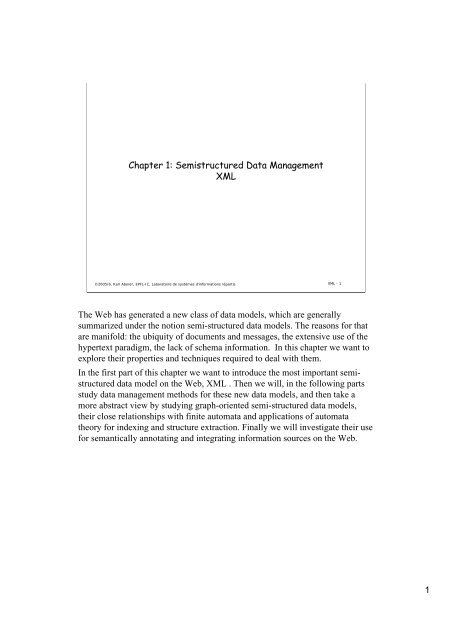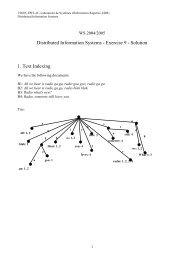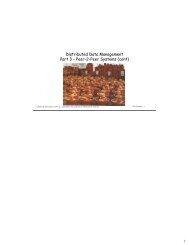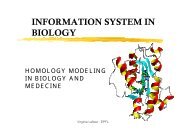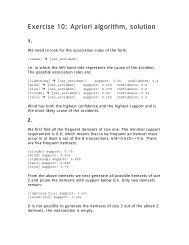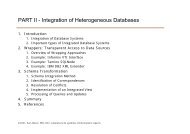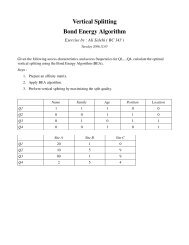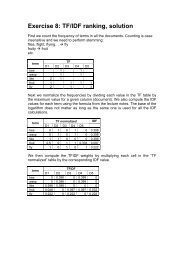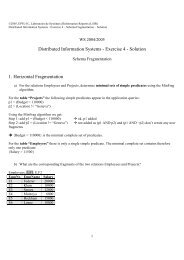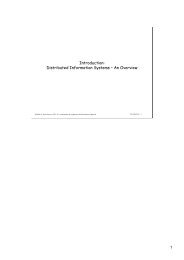Recap XML - LSIR - EPFL
Recap XML - LSIR - EPFL
Recap XML - LSIR - EPFL
Create successful ePaper yourself
Turn your PDF publications into a flip-book with our unique Google optimized e-Paper software.
Chapter 1: Semistructured Data Management<br />
<strong>XML</strong><br />
©2005/6, Karl Aberer, <strong>EPFL</strong>-IC, Laboratoire de systèmes d'informations répartis <strong>XML</strong> - 1<br />
The Web has generated a new class of data models, which are generally<br />
summarized under the notion semi-structured data models. The reasons for that<br />
are manifold: the ubiquity of documents and messages, the extensive use of the<br />
hypertext paradigm, the lack of schema information. In this chapter we want to<br />
explore their properties and techniques required to deal with them.<br />
In the first part of this chapter we want to introduce the most important semistructured<br />
data model on the Web, <strong>XML</strong> . Then we will, in the following parts<br />
study data management methods for these new data models, and then take a<br />
more abstract view by studying graph-oriented semi-structured data models,<br />
their close relationships with finite automata and applications of automata<br />
theory for indexing and structure extraction. Finally we will investigate their use<br />
for semantically annotating and integrating information sources on the Web.<br />
1
Today’s Questions<br />
1. What is <strong>XML</strong> <br />
2. <strong>XML</strong> Syntax<br />
3. XPath and XQuery<br />
©2005/6, Karl Aberer, <strong>EPFL</strong>-IC, Laboratoire de systèmes d'informations répartis <strong>XML</strong> - 2<br />
2
Data on the Web: <strong>XML</strong><br />
• Limitations of HTML<br />
– Structure of data expressed as layout<br />
– Semantics of data hard to analyse and difficult to share<br />
– No schemas, no constraints<br />
• Thus <strong>XML</strong> (eXtensible Markup Language) has been developed<br />
– Markup language to define structured documents<br />
– Document schemas to fix the structure of documents<br />
– User-defined markup to express semantics<br />
– <strong>XML</strong> architecture for processing and extended functionality<br />
©2005/6, Karl Aberer, <strong>EPFL</strong>-IC, Laboratoire de systèmes d'informations répartis <strong>XML</strong> - 3<br />
Eventually data too was represented in HTML (tables, lists, matrices). It quickly<br />
turned out that this was not a good idea as it became hard to interpret the data<br />
correctly, not only for humans but even more for computers. The problem was<br />
that this lacked the good old wisdom that you should define a schema according<br />
to which your data is structured, before you populate a database. Therefore<br />
<strong>XML</strong> was invented. It transferred the merits of schemas into the document<br />
world. Document-orieneted people also like to say that they allow « userdefined<br />
» markup, as opposed to the « system markup » of HTML.<br />
3
Example: <strong>XML</strong> – as document language<br />
©2005/6, Karl Aberer, <strong>EPFL</strong>-IC, Laboratoire de systèmes d'informations répartis <strong>XML</strong> - 4<br />
This is an example of an <strong>XML</strong> document. The most important thing to observe<br />
here is that it consists of a mix of markup, enclosed in and textual content<br />
(everything between). The second observation is that the markup is<br />
hierarchically structured (indicated by the indentation). The syntactic details<br />
will be introduced later.<br />
4
Example: <strong>XML</strong>- as data model<br />
2002-13-12<br />
orderDate<br />
purchaseOrder<br />
shipTo<br />
billTo<br />
comment<br />
items<br />
Hurry …<br />
name street city state zip<br />
124-AA<br />
partNum<br />
item<br />
item<br />
partNum<br />
AliceSmith Mill Valley CA 90952<br />
productName quantity price comment<br />
123 Maple Street<br />
Lawnmower<br />
1 152,99 confirm order<br />
©2005/6, Karl Aberer, <strong>EPFL</strong>-IC, Laboratoire de systèmes d'informations répartis <strong>XML</strong> - 5<br />
5
Data and Documents<br />
• Serialization<br />
Document = medium for<br />
exchange of information<br />
Communication<br />
Information<br />
system 1<br />
Information<br />
system 2<br />
©2005/6, Karl Aberer, <strong>EPFL</strong>-IC, Laboratoire de systèmes d'informations répartis <strong>XML</strong> - 6<br />
6
<strong>XML</strong> Document Type Definition<br />
<br />
<br />
<br />
<br />
<br />
<br />
<br />
<br />
<br />
<br />
<br />
…<br />
<br />
]><br />
©2005/6, Karl Aberer, <strong>EPFL</strong>-IC, Laboratoire de systèmes d'informations répartis <strong>XML</strong> - 7<br />
In addition, <strong>XML</strong> has a kind of schema language, <strong>XML</strong> Document Type<br />
Definitions (DTDs). They specify WHICH element tags may be used and HOW<br />
they can be used.<br />
7
<strong>XML</strong> Architecture<br />
Standard <strong>XML</strong> applications<br />
XHTML, SMIL, P3P, MathML<br />
Specific <strong>XML</strong><br />
Applications<br />
Layout<br />
- XSL<br />
-CSS<br />
API<br />
- DOM<br />
- SAX<br />
Hyperlinks<br />
-XLink<br />
-XPointer<br />
Schemas<br />
-XSDL<br />
-XDTL<br />
Metadata<br />
- RDF, RDFS<br />
-PICS<br />
Queries<br />
- XSLT, XPath<br />
-XQL, <strong>XML</strong>-QL<br />
<strong>XML</strong> 1.0<br />
DTD<br />
Namespaces<br />
Unicode<br />
URI<br />
©2005/6, Karl Aberer, <strong>EPFL</strong>-IC, Laboratoire de systèmes d'informations répartis <strong>XML</strong> - 8<br />
The importance of <strong>XML</strong> lies not only in its inherent properties as document<br />
markup language, but also in the fact that it is used as the basis for a whole<br />
architecture covering almost every aspect of information processing imaginable.<br />
This architecture is developed under the auspices of the W3C consortium and<br />
builds on <strong>XML</strong> 1.0 which has been approved by the W3C. The architecture<br />
comprises the following components:<br />
Programming API’s: DOM and SAX, these are required to build applications<br />
that can process <strong>XML</strong> documents that have been parsed and made available in<br />
main memory.<br />
Layout and hyperlinks: standardize the language constructs needed in order to<br />
represent the hypertext and layout properties of documents.<br />
Programming APIs, Layout and Hyperlinks are covered in the lecture<br />
« Conception of Information Systems »<br />
<strong>XML</strong> Data Management: <strong>XML</strong> Schema and Query provide the languages for<br />
managing large data-oriented documents and document-collections.<br />
Metadata: as <strong>XML</strong> data will be exchanged and processed in many different<br />
places, it will often be necessary to provide additional data (information) about<br />
the data (metadata) in order to enable applications and users to correctly<br />
interpret and use the data.<br />
We will learn in this lecture in detail about data and metadata management.<br />
8
What is <strong>XML</strong> <br />
• Interpretation depends on the viewpoint and intended use<br />
– a language to describe the structure of documents.<br />
– foundation of the W3C architecture for Hypermedia documents on the Web.<br />
– the successor of HTML.<br />
– a method to represent structured data within text documents.<br />
– a standard data exchange format.<br />
– a data model for semi-structured (partially structured) data<br />
• <strong>XML</strong> and Distributed Information Systems<br />
– <strong>XML</strong> as data model for managing semi-structured data<br />
– <strong>XML</strong> as canonical model to integrate heterogeneous data<br />
– <strong>XML</strong> as canonical data format to exchange data among information systems<br />
• Tim Bray:<br />
"<strong>XML</strong> will be the ASCII of the Web – basic, essential, unexciting"<br />
©2005/6, Karl Aberer, <strong>EPFL</strong>-IC, Laboratoire de systèmes d'informations répartis <strong>XML</strong> - 9<br />
The interpretation of what <strong>XML</strong> is depends also on the viewpoint one takes: in<br />
the simplest case it may be considered as a document syntax, but depending on<br />
the context other interpretations are possible. It is a language to describe<br />
hierarchically structured text documents (this is also where the origin of <strong>XML</strong><br />
lies, there was an earlier very similar language SGML from which <strong>XML</strong> was<br />
derived, and that was used by the publishing industry). By the W3C <strong>XML</strong> was<br />
chosen to be the foundation of the whole architecture of the Web, which<br />
explains also why it is called successor of HTML. For database persons <strong>XML</strong> is<br />
another way of how to structure data, with the additional advantage of getting a<br />
textual representation (or a serialization as it is often called) for free. The textual<br />
form of a <strong>XML</strong> document can thus also directly be used to exchange data via<br />
messages, which is why the EDI (Electronic data Interchange) community views<br />
<strong>XML</strong> nowadays as their standard message syntax. From the data perspective<br />
<strong>XML</strong> also lead to a more fundamental change in the way data management is<br />
perceived, namely the focus on the new question of how to manage, of which we<br />
have no or only partial knowledge of how it is structured. We will dedicate part<br />
3 of this chapter mostly to answer this question.<br />
9
Summary<br />
• What is <strong>XML</strong> <br />
• What is the difference between <strong>XML</strong> and HTML <br />
• What is the difference between the <strong>XML</strong> syntax, architecture and<br />
applications <br />
• What is the difference between data and document <br />
• What are applications of <strong>XML</strong> <br />
©2005/6, Karl Aberer, <strong>EPFL</strong>-IC, Laboratoire de systèmes d'informations répartis <strong>XML</strong> - 10<br />
10
2. <strong>XML</strong> Syntax<br />
• Well-formed <strong>XML</strong> conforms to a basic <strong>XML</strong> syntax and some semantic<br />
constraints for well-formedness<br />
• Main concepts<br />
– Elements: used to structure the document, identify a portion of the<br />
document<br />
– Attributes: associate data values with elements, used to reduce the number<br />
of elements and for typed data<br />
– Character data (PCDATA): textual content of the document<br />
<br />
<br />
PCDATA,<br />
the content<br />
<br />
<br />
<br />
more PCDATA<br />
<br />
<br />
©2005/6, Karl Aberer, <strong>EPFL</strong>-IC, Laboratoire de systèmes d'informations répartis <strong>XML</strong> - 11<br />
Though <strong>XML</strong> supports schemas (by means of DTDs) <strong>XML</strong> documents are not<br />
required to have ones. Rather any document that following some basic syntax<br />
concerning the tags are valid <strong>XML</strong> documents. These are called well-formed<br />
<strong>XML</strong> documents. The constituents of an <strong>XML</strong> documents are elements (the<br />
tags), attributes and textual content. The tags must be nested, such that the<br />
elements form a hierarchy. Therefore it is always possible to view an <strong>XML</strong><br />
document also as a tree, as illustrated by the example. It is important to consider<br />
always both views on <strong>XML</strong>, either as document – as in the ASCII (actually<br />
UNICODE) representation on the right -, or as data – as in the tree<br />
representation on the left (trees are a kind of data structure!)<br />
11
Well-Formed <strong>XML</strong> Syntax<br />
• Syntax (excerpt)<br />
document ::= prolog element Misc*<br />
element ::= EmptyElemTag | STag content Etag<br />
STag ::= ''<br />
ETag ::= ''<br />
Attribute ::= Name Eq AttValue<br />
• Syntactic Properties (enforced by grammar)<br />
– single root element<br />
– tag names start with letter<br />
– tags must be properly nested<br />
– special syntax for empty tags<br />
• Semantic Constraints<br />
– Start and end tag name must match<br />
– Attribute names within an element are unique<br />
non-<strong>XML</strong>:<br />
<br />
Alice<br />
<br />
<br />
Bob<br />
<br />
©2005/6, Karl Aberer, <strong>EPFL</strong>-IC, Laboratoire de systèmes d'informations répartis <strong>XML</strong> - 12<br />
Well-formed <strong>XML</strong> can be specified by means of a formal syntax of which we<br />
illustrate only some important production rules. In particular one can see the<br />
hierarchical buildup for the production of element. This syntax implies some<br />
properties that well-formed <strong>XML</strong> documents have. However, there exist more<br />
requirements on well-formed <strong>XML</strong>, which are outside the scope of the syntax.<br />
12
Well-Formed <strong>XML</strong> Syntax<br />
• Syntax (excerpt)<br />
document ::= prolog element Misc*<br />
element ::= EmptyElemTag | STag content Etag<br />
STag ::= ''<br />
ETag ::= ''<br />
Attribute ::= Name Eq AttValue<br />
• Syntactic Properties (enforced by grammar)<br />
– single root element<br />
– tag names start with letter<br />
– tags must be properly nested<br />
– special syntax for empty tags<br />
non-<strong>XML</strong>:<br />
<br />
Alice<br />
<br />
• Semantic Constraints<br />
– Start and end tag name must match<br />
– Attribute names within an element are unique<br />
©2005/6, Karl Aberer, <strong>EPFL</strong>-IC, Laboratoire de systèmes d'informations répartis <strong>XML</strong> - 13<br />
Well-formed <strong>XML</strong> can be specified by means of a formal syntax of which we<br />
illustrate only some important production rules. In particular one can see the<br />
hierarchical buildup for the production of element. This syntax implies some<br />
properties that well-formed <strong>XML</strong> documents have. However, there exist more<br />
requirements on well-formed <strong>XML</strong>, which are outside the scope of the syntax.<br />
13
Well-Formed <strong>XML</strong> Syntax<br />
• Syntax (excerpt)<br />
document ::= prolog element Misc*<br />
element ::= EmptyElemTag | STag content Etag<br />
STag ::= ''<br />
ETag ::= ''<br />
Attribute ::= Name Eq AttValue<br />
• Syntactic Properties (enforced by grammar)<br />
– single root element<br />
– tag names start with letter<br />
– tags must be properly nested<br />
– special syntax for empty tags<br />
• Semantic Constraints<br />
– Start and end tag name must match<br />
– Attribute names within an element are unique<br />
non-<strong>XML</strong>:<br />
<br />
Alice<br />
<br />
<br />
Bob<br />
<br />
©2005/6, Karl Aberer, <strong>EPFL</strong>-IC, Laboratoire de systèmes d'informations répartis <strong>XML</strong> - 14<br />
Well-formed <strong>XML</strong> can be specified by means of a formal syntax of which we<br />
illustrate only some important production rules. In particular one can see the<br />
hierarchical buildup for the production of element. This syntax implies some<br />
properties that well-formed <strong>XML</strong> documents have. However, there exist more<br />
requirements on well-formed <strong>XML</strong>, which are outside the scope of the syntax.<br />
14
Well-Formed <strong>XML</strong> Syntax<br />
• Syntax (excerpt)<br />
document ::= prolog element Misc*<br />
element ::= EmptyElemTag | STag content Etag<br />
STag ::= ''<br />
ETag ::= ''<br />
Attribute ::= Name Eq AttValue<br />
• Syntactic Properties (enforced by grammar)<br />
– single root element<br />
– tag names start with letter<br />
– tags must be properly nested<br />
– special syntax for empty tags<br />
<strong>XML</strong>:<br />
<br />
• Semantic Constraints<br />
– Start and end tag name must match<br />
– Attribute names within an element are unique<br />
©2005/6, Karl Aberer, <strong>EPFL</strong>-IC, Laboratoire de systèmes d'informations répartis <strong>XML</strong> - 15<br />
Well-formed <strong>XML</strong> can be specified by means of a formal syntax of which we<br />
illustrate only some important production rules. In particular one can see the<br />
hierarchical buildup for the production of element. This syntax implies some<br />
properties that well-formed <strong>XML</strong> documents have. However, there exist more<br />
requirements on well-formed <strong>XML</strong>, which are outside the scope of the syntax.<br />
15
Well-Formed <strong>XML</strong> Syntax<br />
• Syntax (excerpt)<br />
document ::= prolog element Misc*<br />
element ::= EmptyElemTag | STag content Etag<br />
STag ::= ''<br />
ETag ::= ''<br />
Attribute ::= Name Eq AttValue<br />
• Syntactic Properties (enforced by grammar)<br />
– single root element<br />
– tag names start with letter<br />
– tags must be properly nested<br />
– special syntax for empty tags<br />
• Semantic Constraints<br />
– Start and end tag name must match<br />
– Attribute names within an element are unique<br />
non-<strong>XML</strong>:<br />
<br />
Alice<br />
<br />
<br />
Bob<br />
<br />
©2005/6, Karl Aberer, <strong>EPFL</strong>-IC, Laboratoire de systèmes d'informations répartis <strong>XML</strong> - 16<br />
Well-formed <strong>XML</strong> can be specified by means of a formal syntax of which we<br />
illustrate only some important production rules. In particular one can see the<br />
hierarchical buildup for the production of element. This syntax implies some<br />
properties that well-formed <strong>XML</strong> documents have. However, there exist more<br />
requirements on well-formed <strong>XML</strong>, which are outside the scope of the syntax.<br />
16
Well-Formed <strong>XML</strong> Syntax<br />
• Syntax (excerpt)<br />
document ::= prolog element Misc*<br />
element ::= EmptyElemTag | STag content Etag<br />
STag ::= ''<br />
ETag ::= ''<br />
Attribute ::= Name Eq AttValue<br />
• Syntactic Properties (enforced by grammar)<br />
– single root element<br />
– tag names start with letter<br />
– tags must be properly nested<br />
– special syntax for empty tags<br />
non-<strong>XML</strong>:<br />
<br />
• Semantic Constraints<br />
– Start and end tag name must match<br />
– Attribute names within an element are unique<br />
©2005/6, Karl Aberer, <strong>EPFL</strong>-IC, Laboratoire de systèmes d'informations répartis <strong>XML</strong> - 17<br />
Well-formed <strong>XML</strong> can be specified by means of a formal syntax of which we<br />
illustrate only some important production rules. In particular one can see the<br />
hierarchical buildup for the production of element. This syntax implies some<br />
properties that well-formed <strong>XML</strong> documents have. However, there exist more<br />
requirements on well-formed <strong>XML</strong>, which are outside the scope of the syntax.<br />
17
<strong>XML</strong> Document Type Definitions (DTDs)<br />
• Definitions<br />
– Definition of element and attribute names<br />
• Content Model (regular expressions)<br />
– Association of attributes with elements<br />
– Association of elements with other elements (containment)<br />
– Order and cardinality constraints<br />
• A valid <strong>XML</strong> document must satisfy the type definition given by the<br />
DTD<br />
©2005/6, Karl Aberer, <strong>EPFL</strong>-IC, Laboratoire de systèmes d'informations répartis <strong>XML</strong> - 18<br />
<strong>XML</strong> document type definitions (DTDs) are used to specify<br />
-which elements and attributes are allowed<br />
-And how they can appear in the document in relation to each other<br />
However, in difference to database schemas they are not given as types (a<br />
relational schema is for example a (data) type definition) but rather as a special<br />
kind of grammar.<br />
18
Element Declarations<br />
• Basic form<br />
– <br />
– contentmodel determines which other elements can be contained<br />
– Given by a regular expression<br />
• Atomic contents<br />
– Element content<br />
<br />
– Text content<br />
<br />
– Empty Element<br />
<br />
– Arbitrary content<br />
<br />
<br />
example<br />
<br />
<br />
<br />
example<br />
<br />
©2005/6, Karl Aberer, <strong>EPFL</strong>-IC, Laboratoire de systèmes d'informations répartis <strong>XML</strong> - 19<br />
The main construct in DTDs is the declaration of elements. It consists of two<br />
parts, the name of the element and the content model, which is a regular<br />
expression that determines which other elements are allowed to appear within<br />
(or below) the element, and in which order and multiplicity. The content model<br />
is a regular expression built up from other element names. The atomic contents<br />
are other elements, text, which is represented by special built-in element name<br />
#PCDATA (=parseable character data), the empty content or any content, which<br />
imposes no further constraints.<br />
19
Element Declarations<br />
• Sequence<br />
<br />
• Alternative<br />
<br />
• Optional (zero or one)<br />
<br />
• Optional and repeatable (zero or more)<br />
<br />
• Required and repeatable (one or more)<br />
<br />
Mixed content<br />
<br />
<br />
<br />
<br />
<br />
<br />
<br />
<br />
example<br />
<br />
• Content model can be grouped by paranthesis (nested expressions)<br />
• Cyclic element containment is allowed in DTD (not document)<br />
©2005/6, Karl Aberer, <strong>EPFL</strong>-IC, Laboratoire de systèmes d'informations répartis <strong>XML</strong> - 20<br />
From the atomic content model one can construct composite content models, by<br />
using the standard regular expression operators sequence, alternative optional<br />
and repeatable. If text content occurs together with user-defined elements in the<br />
content model, this is called mixed content. The regular expression operators<br />
can be nested using parantheses and cyclic element containment is allowed. This<br />
allows for example to specify DTDs that allow documents of arbitrary depth.<br />
20
Attribute Declarations<br />
• Each element can be associated with an arbitrary number of attributes<br />
• Basic form<br />
– <br />
• Example:<br />
Document Type Definition<br />
<br />
<br />
Document<br />
… <br />
©2005/6, Karl Aberer, <strong>EPFL</strong>-IC, Laboratoire de systèmes d'informations répartis <strong>XML</strong> - 21<br />
Attributes are used to associate additional data with elements that are not<br />
represented as contents. Attributes are a heritage from the document processing<br />
world, where the elements have been used to structure the documents, and<br />
attributes were used to specify instructions for document processing. From a<br />
data modeling viewpoint, in many cases attributes and elements can be used<br />
interchangeably, and the preference is a matter of taste and capabilities of the<br />
<strong>XML</strong> processing environment.<br />
21
Attribute Declarations - Types<br />
• CDATA<br />
– String<br />
– <br />
• Enumeration<br />
– Token from given set of values, Default possible<br />
– <br />
• Possible Defaults<br />
– Required attribute: #REQUIRED<br />
– Optional attribute: #IMPLIED<br />
– Fixed attribute: #FIXED "value"<br />
– Default: "value"<br />
• Other attribute types: IF, IDREF, ENTITY, ENTITIES, NOTATION,<br />
NAME, NAMES, NMTOKEN, NMTOKENS<br />
©2005/6, Karl Aberer, <strong>EPFL</strong>-IC, Laboratoire de systèmes d'informations répartis <strong>XML</strong> - 22<br />
Attributes can be typed. The standard type of an attribute is CDATA, i.e.<br />
Strings. Enumerations allow to specify finite sets of data values (note that the<br />
same could be achieved by defining an appropriate DTD, with an empty element<br />
type for each data value.) The ID/IDREF mechanisms is one case where<br />
attributes’ expressive power goes beyond that of elements. It allows to specify<br />
references WITHIN documents. It is required in the <strong>XML</strong> specification that an<br />
<strong>XML</strong> parser must check referential integrity of those references. A number of<br />
other attribute types witness the origins of <strong>XML</strong> in the document processing<br />
world, and are not of relevance for our further use of <strong>XML</strong>. The most notable<br />
among those are entities, which provide a kind of macro mechanism, that allows<br />
to factor out repeating parts in the documents and document type definitions.<br />
22
Usage of DTDs<br />
External DTD Declaration<br />
<br />
<br />
"test" is a document element <br />
Internal DTD Declaration<br />
<br />
<br />
©2005/6, Karl Aberer, <strong>EPFL</strong>-IC, Laboratoire de systèmes d'informations répartis <strong>XML</strong> - 23<br />
The DTD can be stored in a separate document, which is useful when it is shared<br />
by many applications/documents, or be directly enclosed into the document,<br />
which is useful when a document is exchanged and the DTD is not known by<br />
the receiver. It is also possible to include only parts of the DTD in the document,<br />
which makes practical sense only when using the entity mechanism.<br />
23
Summary<br />
• Which syntactic and semantic constraints are imposed on a well-formed<br />
<strong>XML</strong> document <br />
• Which atomic element types and operators can be used to build an<br />
element content model <br />
• Which default values exist for attributes <br />
• What is the ID/IDREF mechanism <br />
• Is a DTD always a separate document <br />
©2005/6, Karl Aberer, <strong>EPFL</strong>-IC, Laboratoire de systèmes d'informations répartis <strong>XML</strong> - 24<br />
24
3. XPath and XQuery<br />
2002-13-12<br />
orderDate<br />
purchaseOrder<br />
shipTo<br />
billTo<br />
comment<br />
items<br />
Hurry …<br />
name street city state zip<br />
124-AA<br />
partNum<br />
item<br />
item<br />
partNum<br />
AliceSmith Mill Valley CA 90952<br />
productName quantity price comment<br />
123 Maple Street<br />
Lawnmower<br />
1 152,99 confirm order<br />
“find the price of all items in the purchaseOrder with partNum “124-AA”<br />
©2005/6, Karl Aberer, <strong>EPFL</strong>-IC, Laboratoire de systèmes d'informations répartis <strong>XML</strong> - 25<br />
The problem to address is the following: given an <strong>XML</strong> document, how can we<br />
answer queries as the following: “find the price of all items in the purchaseOrder<br />
with partNum “124-AA”. For relational databases this would be a typical query<br />
to be expressed in SQL. We introduce now the corresponding counterparts for<br />
<strong>XML</strong>.<br />
25
Example XPath Query<br />
2002-13-12<br />
orderDate<br />
purchaseOrder<br />
shipTo<br />
billTo<br />
comment<br />
items<br />
Hurry …<br />
name street city state zip<br />
124-AA<br />
partNum<br />
item<br />
item<br />
partNum<br />
AliceSmith Mill Valley CA 90952<br />
productName quantity price comment<br />
123 Maple Street<br />
Lawnmower<br />
1 152,99 confirm order<br />
/purchaseOrder/items/item[@partnum=“124-AA"]/price<br />
©2005/6, Karl Aberer, <strong>EPFL</strong>-IC, Laboratoire de systèmes d'informations répartis <strong>XML</strong> - 26<br />
26
Example XPath Query<br />
2002-13-12<br />
orderDate<br />
purchaseOrder<br />
shipTo<br />
billTo<br />
comment<br />
items<br />
Hurry …<br />
name street city state zip<br />
124-AA<br />
partNum<br />
item<br />
item<br />
partNum<br />
AliceSmith Mill Valley CA 90952<br />
productName quantity price comment<br />
123 Maple Street<br />
context<br />
location path<br />
Lawnmower<br />
1 152,99 confirm order<br />
filter<br />
absolute<br />
location /purchaseOrder/items/item[@partnum=“124-AA"]/price result<br />
path<br />
location step<br />
©2005/6, Karl Aberer, <strong>EPFL</strong>-IC, Laboratoire de systèmes d'informations répartis <strong>XML</strong> - 27<br />
27
XPath Location Paths<br />
• A location step consists of<br />
– an axis (the navigation direction),<br />
– a node test, and<br />
– a predicate<br />
• Axis operators<br />
– AxisName ::= 'ancestor' | 'ancestor-or-self' | 'attribute'<br />
| 'child' | 'descendant' | 'descendant-or-self' |<br />
'following'| 'following-sibling' | 'namespace' | 'parent' |<br />
'preceding' | 'preceding-sibling' | 'self'<br />
• Example: absolute location path<br />
/child::purchaseorder[child::shipto/child::name="Alice"]/<br />
child::items/child::item[position()=1]<br />
• Abbreviated syntax (used in practice)<br />
/purchaseorder[shipto/name="Alice"]/items/item[1]<br />
©2005/6, Karl Aberer, <strong>EPFL</strong>-IC, Laboratoire de systèmes d'informations répartis <strong>XML</strong> - 28<br />
The simple navigation pattern in the previous example (downwards to elements<br />
with specific names) is generalized in Xpath. Each navigation step is<br />
characterized by three things:<br />
The direction, i.e. a navigation needs not necessarily move from a parent to a<br />
child node, but can follow any relation among elements, in particular by<br />
traversal of elements at the same tree level according to the document order<br />
(following, preceding) and traversal of multiple nodes (descendants). A<br />
complete account of the possible navigation operators is given. The node test<br />
checks whether a element node that is encountered in the navigation matches a<br />
certain element name. And finally the predicates are the filter expressions which<br />
allow to select nodes based on other properties than their name. In particular,<br />
filters allow to use other Xpath queries to check a property of an element. In that<br />
case the predicate is considered as successfully evaluated if a non-empty result<br />
set is generated. In order to take account of the different axis operators an<br />
extended syntax is used in Xpath that specifies for each location step the axis<br />
operator. In practice however, the abbreviated syntax that we have already seen<br />
is more common.<br />
28
Example<br />
2002-13-12<br />
orderDate<br />
purchaseOrder<br />
orderDate<br />
shipTo<br />
billTo<br />
comment<br />
items<br />
item<br />
Hurry …<br />
item/price<br />
name street city state zip<br />
124-AA<br />
item<br />
item<br />
./item<br />
partNum<br />
item/..<br />
partNum<br />
context items<br />
*/*<br />
item/@*<br />
productName quantity price comment<br />
AliceSmith item[1] Mill Valley CA 90952<br />
item[1,4]<br />
item[price]<br />
item[productName="Lawnmower"]<br />
123 Maple Street<br />
item[@partNum=124-AA]<br />
/purchaseOrder//item<br />
Lawnmower 1 152,99 confirm order<br />
/purchaseOrder/*/item<br />
/purchaseOrder[billTo]/items[item]<br />
/purchaseOrder[items/item]<br />
/purchaseOrder[billTo and shipTo]<br />
©2005/6, Karl Aberer, <strong>EPFL</strong>-IC, Laboratoire de systèmes d'informations répartis <strong>XML</strong> - 29<br />
29
XQuery - Querying <strong>XML</strong> Data<br />
• Problem: XPath lacks basic capabilities of database query languages, in<br />
particular join capability and creation of new <strong>XML</strong> structures<br />
• XQuery extends XPath to remedy this problem<br />
• Additional concepts in XQuery<br />
– Extended path expressions<br />
– Element constructors<br />
– FLWR expressions<br />
– Expressions involving operators and functions<br />
– Conditional expressions<br />
– Quantified expressions<br />
©2005/6, Karl Aberer, <strong>EPFL</strong>-IC, Laboratoire de systèmes d'informations répartis <strong>XML</strong> - 30<br />
By now it should have become clear that Xpath lacks basic capabilities one<br />
would expect from a (declarative, set-oriented) database querying language. In<br />
particular it has no general support for set operators, it allows to return only<br />
element and attribute sets and is thus not closed and it has no support of an<br />
operation that is equivalent to a relational join, which would be required to<br />
establish value-based relationships among <strong>XML</strong> document parts. We introduce<br />
now the most important additional concepts of XQuery as they were specified in<br />
June 2001. The goal is not to obtain a thorough knowledge and capability to use<br />
Xquery, but to understand the substantial additional concepts to Xpath and the<br />
relationships to SQL. We must be aware that this standard is not yet finalized<br />
and we may expect certain changes (probably not major ones).<br />
With a knowledge of Xpath and SQL the following presentation of Xquery<br />
should be straightforward to follow.<br />
30
Element Constructor and FLWR Expressions<br />
• <br />
{<br />
LET $a := avg(document("bib.xml")//book/price)<br />
FOR $b IN document("bib.xml")//book<br />
WHERE $b/price > $a<br />
RETURN<br />
<br />
{$b/title}<br />
<br />
{$b/price - $a}<br />
<br />
<br />
}<br />
<br />
"macro"<br />
"FROM"<br />
"SELECT"<br />
• For each book whose price is greater than the average price, return the title of the<br />
book and the amount by which the book's price exceeds the average price<br />
©2005/6, Karl Aberer, <strong>EPFL</strong>-IC, Laboratoire de systèmes d'informations répartis <strong>XML</strong> - 31<br />
This query exhibits a whole wealth of new concepts of Xquery. Most notably<br />
one can see that Xquery allows variable binding as SQL. Different to SQL<br />
where relations are available to bind variables in Xquery they have to bind to<br />
sets that result from other Xquery expressions (this is the only possibility to<br />
obtain sets). This is done in the FOR clause. In addition using the LET clause<br />
one can introduce variables that factor out repeatedly occurring expressions in<br />
the queries. Note that these variables are used very differently from the ones<br />
bound to set valued expressions: they are just syntactically replaced in the query.<br />
The second observation is that new a WHERE clause is available to express<br />
conditions. This allows in particular to express joins when multiple variables are<br />
bound in the FOR clause. The third observation is that a RETURN clause allows<br />
to return structured results, creating new <strong>XML</strong> document fragments. Finally we<br />
see that a query expression itself can be nested within a <strong>XML</strong> document<br />
fragment.<br />
31
FLWR Expression Evaluation<br />
©2005/6, Karl Aberer, <strong>EPFL</strong>-IC, Laboratoire de systèmes d'informations répartis <strong>XML</strong> - 32<br />
The semantics of Xquery expressions is defined similarly to SQL (which is in<br />
short: build the Cartesian product of the relations in the FROM clause, evaluate<br />
the predicates in the WHERE clause and then project on the attributes in the<br />
SELECT clause). Also for FLWR expression first generate all tuples from the<br />
Cartesian product space of all sets to which variables are bound. An important<br />
difference that the order among document elements needs to be preserved,<br />
therefore also the order in which the variables appear in the FOR clause has an<br />
impact on the order the result tuples will be sorted. The WHERE clause is<br />
evaluated as for SQL and for each remaining tuple an <strong>XML</strong> document fragment<br />
is generated by replacing the variables by the tuple values. There is also a <strong>XML</strong><br />
query algebra under development which is intended to provide a precise<br />
semantics to Xquery. As all these are ongoing developments we will not further<br />
delve into the technical details, as the final outcome of these developments is<br />
not yet determined.<br />
32
©2005/6, Karl Aberer, <strong>EPFL</strong>-IC, Laboratoire de systèmes d'informations répartis <strong>XML</strong> - 33<br />
33
Q1<br />
absolute<br />
location<br />
path<br />
XPath<br />
expression<br />
element<br />
newly<br />
generated<br />
element<br />
copied from<br />
source<br />
©2005/6, Karl Aberer, <strong>EPFL</strong>-IC, Laboratoire de systèmes d'informations répartis <strong>XML</strong> - 34<br />
34
Q2<br />
dependent<br />
variables<br />
©2005/6, Karl Aberer, <strong>EPFL</strong>-IC, Laboratoire de systèmes d'informations répartis <strong>XML</strong> - 35<br />
35
Q3<br />
how is this query different<br />
from Q2 <br />
©2005/6, Karl Aberer, <strong>EPFL</strong>-IC, Laboratoire de systèmes d'informations répartis <strong>XML</strong> - 36<br />
36
Q5<br />
join condition<br />
©2005/6, Karl Aberer, <strong>EPFL</strong>-IC, Laboratoire de systèmes d'informations répartis <strong>XML</strong> - 37<br />
37
Functions<br />
• NAMESPACE<br />
xsd=http://www.w3.org/2001/03/<strong>XML</strong>Schema-datatypes<br />
FUNCTION depth(ELEMENT $e) RETURNS xsd:integer<br />
{ -- An empty element has depth 1<br />
-- Otherwise, add 1 to max depth of children<br />
IF empty($e/*) THEN 1<br />
ELSE max(depth($e/*)) + 1 }<br />
depth(document("partlist.xml"))<br />
• Find the maximum depth of the document named "partlist.xml."<br />
©2005/6, Karl Aberer, <strong>EPFL</strong>-IC, Laboratoire de systèmes d'informations répartis <strong>XML</strong> - 38<br />
Xquery goes much further in terms of expressiveness than SQL by allowing the<br />
definition of arbitrary user-defined functions. This is a feature that can be found<br />
in SQL99 (as well), the object-relational query language standard building on<br />
SQL92. We also see in this example, that Xquery uses type specifications that<br />
are provided in the <strong>XML</strong> Schema standard, which too is currently under<br />
development.<br />
38
Existential and Universal Quantifiers<br />
• FOR $b IN //book<br />
WHERE<br />
SOME $p IN $b//para SATISFIES contains($p, "sailing")<br />
AND contains($p, "windsurfing")<br />
RETURN $b/title<br />
• Find titles of books in which both sailing and windsurfing are mentioned in the same<br />
paragraph.<br />
• FOR $b IN //book<br />
WHERE<br />
EVERY $p IN $b//para SATISFIES contains($p, "sailing")<br />
RETURN $b/title<br />
• Find titles of books in which sailing is mentioned in every paragraph.<br />
©2005/6, Karl Aberer, <strong>EPFL</strong>-IC, Laboratoire de systèmes d'informations répartis <strong>XML</strong> - 39<br />
As in SQL, Xquery also supports the concepts of universal and existential<br />
quantification of variables ranging over set expressions.<br />
39
Q4<br />
XPath expression returns exactly all<br />
different authors<br />
nested query<br />
existential<br />
quantifier<br />
Boolean function<br />
©2005/6, Karl Aberer, <strong>EPFL</strong>-IC, Laboratoire de systèmes d'informations répartis <strong>XML</strong> - 40<br />
40
Summary<br />
• What is the relationship between XPath and XQuery <br />
• Which result types are possible in XPath <br />
• What is an axis in XPath <br />
• What is the difference between a/*/b and a//b <br />
• How can a join operation be specified using XQuery <br />
• What are differences and commonalities among XQuery and SQL92 <br />
©2005/6, Karl Aberer, <strong>EPFL</strong>-IC, Laboratoire de systèmes d'informations répartis <strong>XML</strong> - 41<br />
41
References<br />
• WebSite<br />
– <strong>XML</strong>, XPath, XQuery: http://www.w3.org/<br />
– also links to vendors that implement XQuery<br />
• Book<br />
– S. Abiteboul, P. Bunemann, D. Suciu: Data on the Web: From Relations to<br />
Semistructured Data and <strong>XML</strong>, Morgan Kaufman, 2000.<br />
©2005/6, Karl Aberer, <strong>EPFL</strong>-IC, Laboratoire de systèmes d'informations répartis <strong>XML</strong> - 42<br />
42


